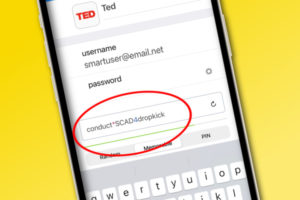With the news last week that Zoom had some big security concerns to patch up, educators of all kinds started seeking out Zoom alternatives for schools and other kinds of remote learning. Especially after the NYC DOE took the big step of forbidding NYC public schools from using Zoom until “it’s safe enough to use.”
While some issues were related to fixable user error (hosting public instead of private meetings, posting meeting codes too early, inappropriate behavior by students), some of them were not
NY State Attorney General Letitia James is looking into Zoom security and privacy issues including webcam hacking, user data being sent to Facebook (for no reason at all), encryption issues, and lack of geofencing which contributed to some calls being routed through China. Zoom founder and CEO Eric Yuan responded with a thoughtful blog post, acknowledging problems with Zoom, and detailing actions they’ve taken, and actions they still have yet to take as part of their 90-day plan to shore up security.
Now to be clear: I am not freaking out. At all. I am still using Zoom myself, including a parent-faculty online meeting with our school just last night. However, I entirely understand the NYC Chancellor’s decision; allowing 1.1 million children to use a platform that hasn’t locked down their data privacy and security issues can open the DOE up to a whole lot of liability.
Or as Mark Bower, a cybersecurity expert at comforte AG explained, “Even with statements of compliance to COPPA (children’s privacy rules regulated by the FTC) and FERPA laws (education data and student privacy), a breach or exploit can result in major reputation compromise and bans. Data security is tough to get right, but organizations need to take it extremely seriously.”
I do have confidence that Zoom will fix the issues, and quickly, as does one high school principal I spoke with, who has been in touch with Zoom directly. Schools may be back to using Zoom soon, especially it remains the best platform for video distance learning under lots of circumstances — like for my teen daughter, who’s in a performing arts school, and needs to be able to see all the other students at once.
However, the need for Zoom alternatives is real right now.
So I asked our Out Tech Your Kids community of parents for Zoom alternatives that their schools are using around the country. Their responses, along with research from various tech and security experts, helped me put together this list, if you’re looking for Zoom alternatives right now.
I’m not going into wild amounts of detail here, but enough that you can click see what might be applying, click through, and research the details of the program that might be best for your school’s situation right now.
Related: Ways to practice safe socializing using tech during the Coronavirus outbreak
7 Zoom alternatives for education worth checking out

Image: Microsoft
1. Google Meet
Formerly Google Hangouts, this is an extremely popular Zoom alternative for schools, particularly because so many are already using Google Classroom suites. Through July 1, 2020, educators have free access to premium videoconference features for distance learning like larger meetings for grade-wide assemblies, live-streaming, and video recording. They’ve recently added an update (it will be fully functional over the next 2-3 weeks) with great features like allowing a meeting creator to see and approve all requests to join the meeting — even including students with email addresses that are not part of the school’s G Suite Domain (e.g. fliebowitz@emilydickinsoncollege.com). Teachers now will be the only ones able to mute or remove participants, and meetings cannot be rejoined by a student once the teacher has left. Plenty of schools are moving here from Zoom right now, and it’s a solid, trusted option.
2. Microsoft Teams
Another wildly popular alternative to Zoom for schools is Microsoft’s Teams collaboration platform. Especially because it you can sign your school up for free right now. It’s actually a part of Office 365 so it integrates with all the other tools you may already be using — Word, Powerpoint, Excel — and those are currently free for educators and classrooms as well. I like that they offer a lot of tips specific to distance learning, from how to ensure your system is secure, to tricks for keeping kids students engaged and focused. Terrific solution that lots of our readers have been really happy using, and giving them a lot of confidence in terms of privacy and data security for their kids.
That’s echoed by Paul Bischoff, a privacy advocate with Comparitech, who mentions Microsoft Teams as allowing for more top-down security control. “An IT administrator can set the rules and verify participants. It’s much less ad hoc and easier to secure [than Zoom] from an operational perspective.”
3. Blackboard Collaborate
Because it was designed exclusively for classroom use, Blackboard has an impressively robust range of offerings for schools. It’s a complete digital learning environment (like Google Classroom) that’s already used by 1 in 3 US school districts, with a cutting-edge HD virtual classroom for group video that teachers and students seem to love. It’s also popular at the college level; I spoke with a former university professor of mine who explained they use it school-wide with great success, and even integrate Zoom conferencing through their secure Blackboard platform.
The one downside: It’s suuuuper expensive. It’s tough tracking down actual costs, but I’ve seen numbers around $160k a year for a school district license. Not sure if they’re cutting that in light of pandemic school closures (hint hint) because a lot of public school districts would struggle to be able to afford this.
4. Skype Conference Call
This isn’t a complete classroom solution, but it can solve for the need for occasional classroom video conferences. Unlike with regular Skype, you don’t need an account or to download the app (though you can use the app of course) — you don’t even need to be signed in. You can just use the web client, or in human terms, click the link for your meeting and just join through your browser on desktop. This could be good for classes, or they might want to see exactly who is on each call. Another plus: because it’s owned by Microsoft now (did you know that?) there’s excellent security and integration with some other Microsoft products and platforms.
5. Cisco WebX Videoconferencing
The online, HD video meeting and screen sharing software that’s popular with businesses everywhere is a Zoom alternative for schools to consider that may not be high on your radar. They just upgraded their free plan for those impacted by COVID-19 closures (thank you!), giving you 100 participants per meeting (formerly 50), and upping time limits from 40 minutes to unlimited. I notice that their online learning page is called online training — an indicator that this really wasn’t developed for education — but is worth a look for more details. You might also look into their business accounts which cost from $13.50- $26.95/month, and may provide more of the security features that schools need.
6. Bluejeans
I’m not as familiar with the Bluejeans platform, but a friend who uses it for business swears by it and I’m so happy that I learned more. One of the big benefits, besides a claim to excellent security and encryption, is the integration of Dolby sound — and as we all know, sound quality can make or break a video classroom session! While it’s not designed specifically for education, you can see in this post how University of Michigan is using Bluejeans for remote learning during COVID-19, and how they virtualized more than 4,000 courses in just four days, and are now using 2.57 million participant minutes per day. Wow. Plans range from $9.99-$13.99/mo, with an Enterprise plan available with unlimited recordings, and a lot more personal tech support. Worth a look.
7. Whereby
One reader suggests Whereby, another pay service for video conferencing and group meetings. As with Skype Conference Call, there’s no need to download an app or to even sign-in to join a conference, which again, has plusses and minuses when it comes to digital classrooms. Schools would need a business account, which starts at $59.99/month, and gives you up to 50 participants. Unfortunately, only 12 can be on video at the same time, with the rest on audio. So it’s not so great for performing arts classes, or classes where teachers really want to see their students all at once — unless you’re lucky enough to have a class size under 12. Preschool perhaps?
Top image: Annie Spratt via Unsplash






Great list! I appreciate the alternatives since Zoom has its quirks. I’m especially curious about Google Meet—has anyone found it user-friendly for classrooms? Thanks for sharing these options!